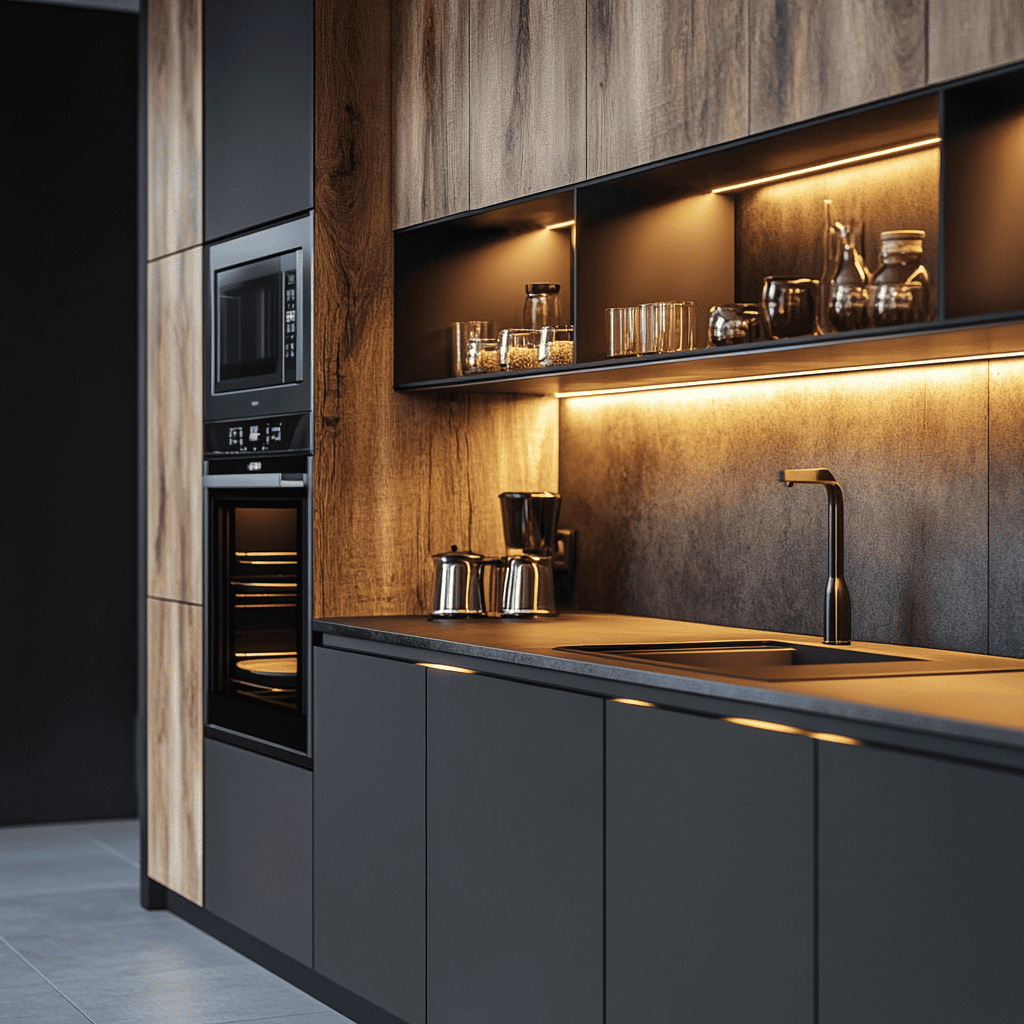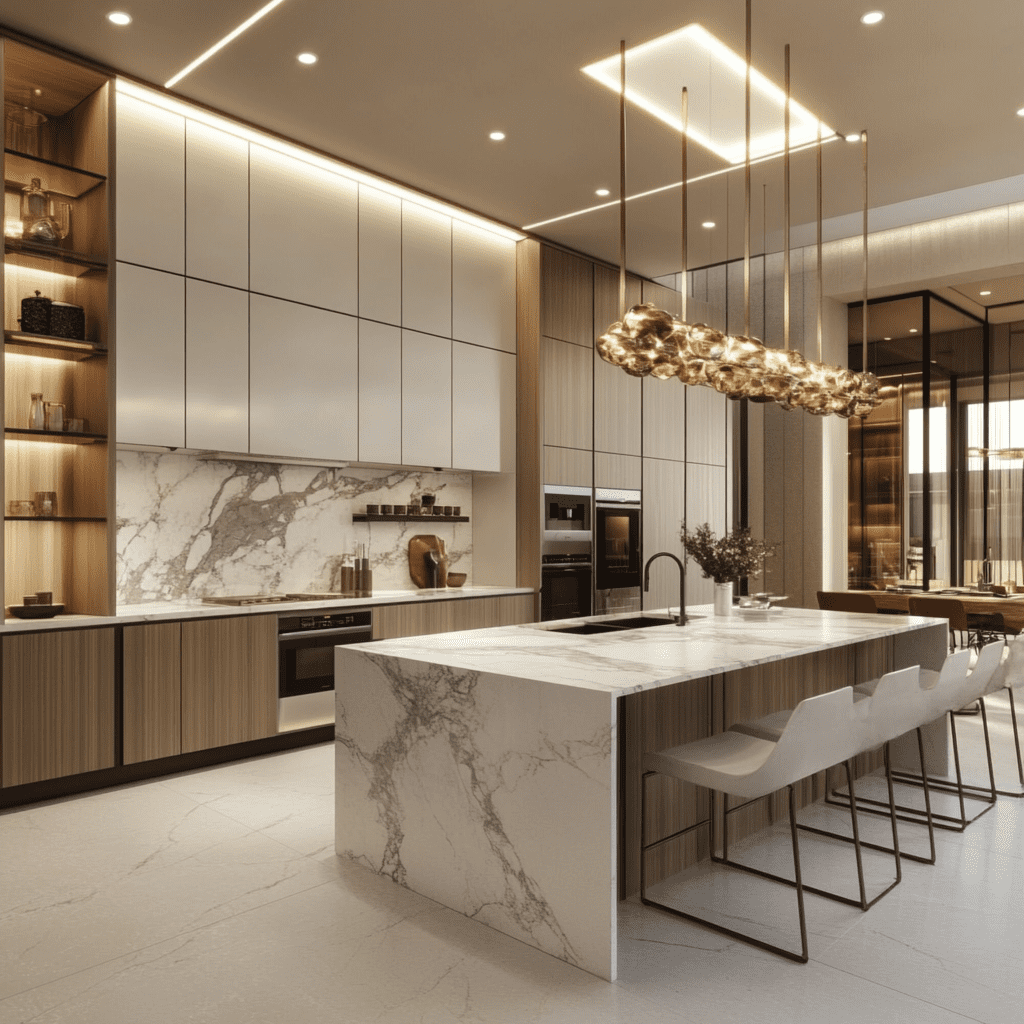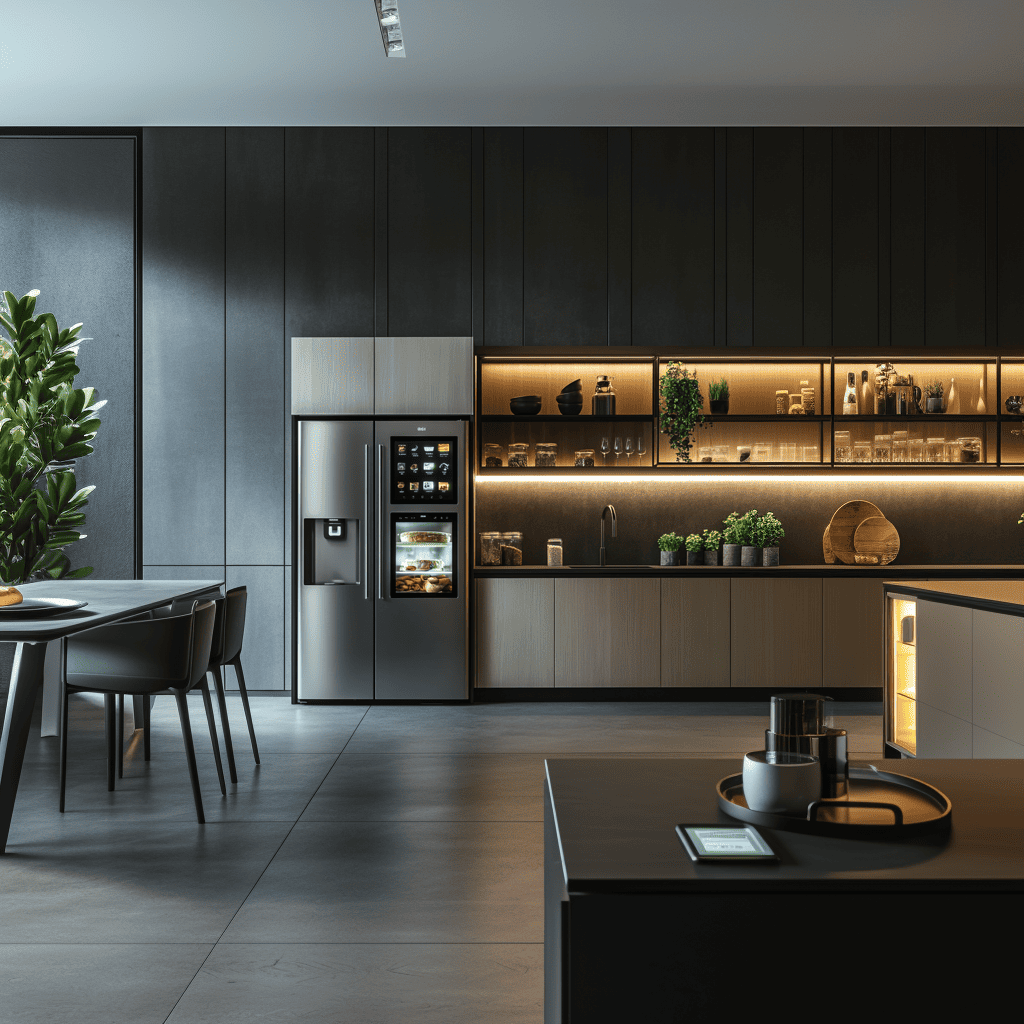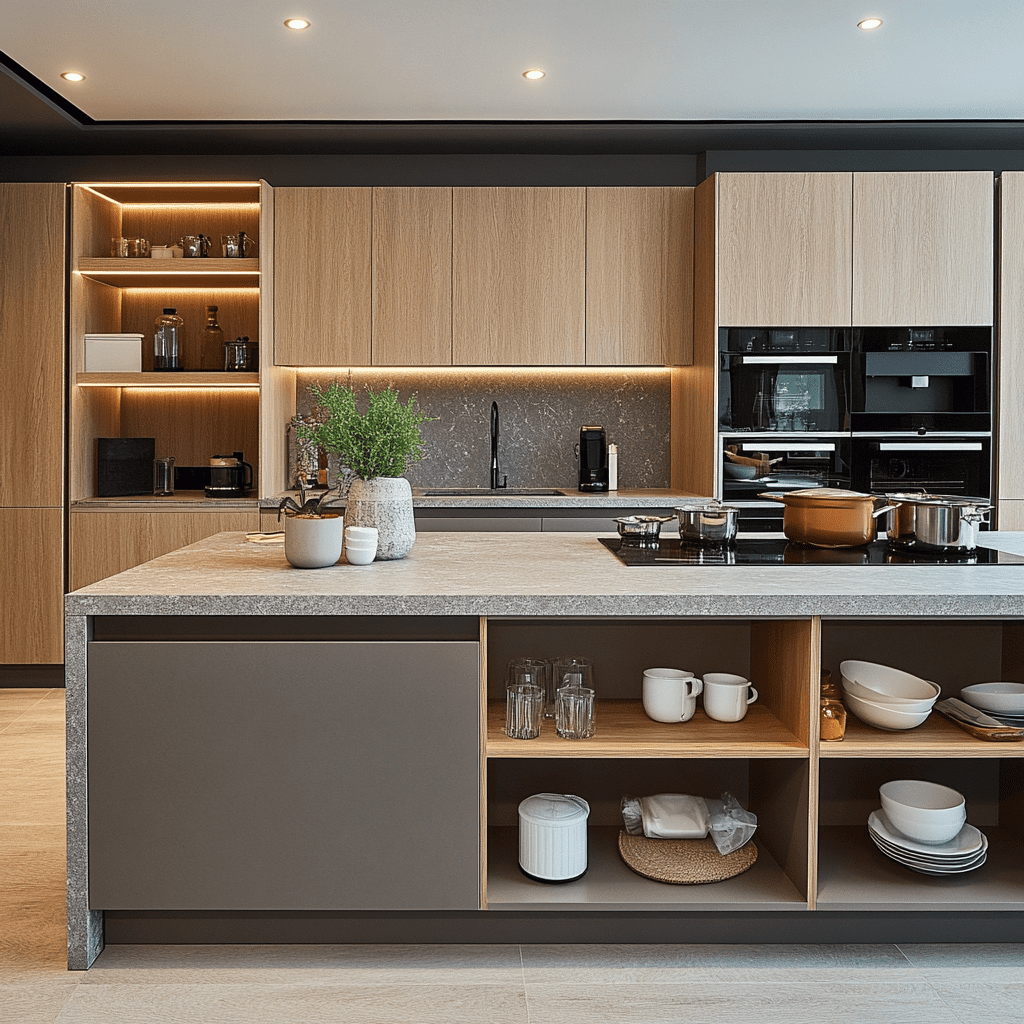Designing and Equipping an Integrated Kitchen
complete guide
How to Choose Materials for Your Integrated Kitchen
Choosing the right materials for your integrated kitchen is one of the most important decisions you’ll make when designing this essential space in your home. Materials not only define the kitchen’s aesthetic, but they also determine its durability, functionality, and ease of maintenance. In this article, we will explore the key factors to consider when selecting materials for an integrated kitchen, ensuring that the final result is both attractive and practical.
1. Countertops: Durability and Style
Countertops are one of the most used surfaces in any kitchen, so choosing the right material is crucial. In an integrated kitchen, the countertops should combine durability with an elegant design.
Quartz: Quartz is a popular option due to its durability and wide variety of colors and finishes. It is resistant to stains, scratches, and heat, making it an ideal material for high-traffic kitchens. Moreover, its sophisticated appearance perfectly suits modern designs.
Granite: Granite is another durable material that adds a natural touch to the kitchen. Each piece of granite is unique, which gives your space an exclusive feel. However, it requires periodic sealing to maintain its stain resistance.
Solid Surfaces: Solid surfaces, like Corian, offer a seamless appearance and are easy to repair if damaged. These surfaces can be molded into seamless shapes, making them perfect for an integrated kitchen with clean and minimalist lines.
2. Wall Coverings: Combining Functionality and Aesthetics
The wall covering, especially in the backsplash area, is another essential aspect of an integrated kitchen. This element should protect the walls from splashes while complementing the overall design.
Ceramic Tiles: Ceramic tiles are a classic and functional option. They are easy to clean, heat-resistant, and come in an endless variety of styles, colors, and patterns. You can choose large tiles for a more modern look or create a unique design with mosaics.
Tempered Glass: Tempered glass is a modern and elegant option that reflects light, making the kitchen appear larger and brighter. It is heat-resistant and easy to clean, which makes it an ideal material for an integrated kitchen.
Stainless Steel Panels: For an industrial and ultra-modern look, stainless steel panels are an excellent choice. They are extremely durable, resistant to stains and bacteria, and easy to maintain, making them perfect for high-traffic kitchens.
3. Cabinets: Materials That Combine Style and Durability
Cabinets are essential in an integrated kitchen, as they not only provide storage but also define the style and functionality of the space.
MDF (Medium-Density Fiberboard): MDF is a popular choice for cabinets due to its versatility and affordability. It can be lacquered or covered with high-quality laminates to mimic wood, offering a modern and sleek appearance. Additionally, it is resistant to warping, ensuring its durability.
Solid Wood: Solid wood, such as oak or walnut, adds a touch of luxury and durability to the kitchen. While it is more expensive, its longevity and the aesthetic value it adds make the investment worthwhile. For an integrated kitchen, opt for finishes in natural tones or dark stains for a sophisticated look.
High-Pressure Laminates: High-pressure laminates are scratch- and stain-resistant and come in a wide variety of colors and textures. They are an excellent option for an integrated kitchen, where a contemporary look is desired without sacrificing durability.

4. Floors: Aesthetic and Functionality Underfoot
The floor of an integrated kitchen must be durable, easy to clean, and of course, aesthetically pleasing. Since the kitchen is a high-traffic area, choosing the right flooring material is crucial.
Porcelain: Porcelain is one of the most popular materials for kitchen floors due to its durability and resistance to stains and water. It is available in a variety of styles that can mimic wood, marble, or concrete, offering great versatility in design.
Luxury Vinyl: Luxury vinyl is a modern option that has gained popularity due to its ability to replicate the appearance of natural materials such as wood or stone, but at a lower cost and greater water resistance. It is comfortable underfoot and easy to maintain, making it an ideal choice for an integrated kitchen.
Wood Floors: Although wood may not be the first choice for a kitchen due to its susceptibility to water, well-treated and sealed wood floors can add warmth and elegance to an integrated kitchen. Opt for hardwoods like oak or maple for greater durability.
5. Lighting: Materials that Enhance the Atmosphere
Lighting is key in an integrated kitchen to highlight materials and create a cozy, functional environment.
Ceiling Lights: Choose ceiling lamps made from stainless steel or glass for a modern look. These lamps not only provide the necessary lighting but also serve as decorative elements that complement the overall design.
Under-Cabinet Lighting: Installing LED lights under the cabinets is a great way to illuminate work areas. LEDs are energy-efficient and come in various tones, from warm white to daylight, allowing you to adjust the kitchen’s atmosphere as needed.
6. Integrated Appliances: Design and Functionality in One
In an integrated kitchen, appliances should be chosen not only for their functionality but also for how they integrate with the overall design.
Stainless Steel: Stainless steel appliances are a popular choice in modern kitchens due to their durability and ability to seamlessly integrate with almost any design style. Additionally, their shiny finish adds a touch of modernity and sophistication.
Panelized Appliances: For true integration in an integrated kitchen, consider panelized appliances that can be covered with the same material as the cabinets. This creates a uniform and seamless look that reinforces the cohesive design of the kitchen.
Choosing materials for your integrated kitchen is a task that requires attention to detail and careful consideration of how each material will contribute to the overall design and functionality of the space. By selecting durable, easy-to-maintain, and aesthetically appealing materials, you can create a kitchen that is not only beautiful but also practical and long-lasting. In the end, the right combination of materials will ensure that your integrated kitchen is a space you’ll enjoy for many years.
Designing Spaces in an Integrated Kitchen: Functionality and Style
The design of a modern integrated kitchen is not just about selecting the best materials or the most advanced appliances; it is also crucial to plan and organize the space in a way that combines functionality and style. In a modern integrated kitchen, every inch counts, and the goal is to create an efficient and aesthetically appealing space that meets the user’s needs. Below, we will explore how to design the key spaces in a modern integrated kitchen, ensuring that the final result is both practical and stylish.
1. Space Layout: The Work Triangle
One of the fundamental principles in designing a modern integrated kitchen is organizing the space around the “work triangle.” This concept refers to the efficient arrangement of the three main areas of the kitchen: the cooking zone (stove or cooktop), the washing zone (sink and dishwasher), and the storage zone (fridge and pantry).
Movement Efficiency: In a well-designed kitchen, these three zones should be placed at a reasonable distance from each other to minimize effort and maximize efficiency. The goal is for the user to move easily between these areas without obstacles, making food preparation and cleaning more efficient.
Adequate Distances: In a modern integrated kitchen, it’s important to maintain balanced distances between these zones. For example, the distance between the stove and sink should be short enough to facilitate the transfer of cooked food, but long enough to avoid clutter. The same applies to the relationship between the fridge and the stove.
2. Maximizing Vertical Space
Vertical space is an invaluable resource in a modern integrated kitchen, especially in kitchens with limited dimensions. Making use of the walls for storage and organization can free up counter space and improve overall functionality.
Cabinets to the Ceiling: Installing cabinets that reach the ceiling maximizes storage space and prevents dust from accumulating on top of the furniture. These cabinets can be used to store infrequently used items, such as additional appliances or special dishware.
Open Shelving: Open shelving is a popular trend in modern integrated kitchens. It not only adds a decorative element but also makes daily-use utensils more accessible. Additionally, it allows for displaying decorative items, such as plants, cookbooks, or attractive dishware, adding a touch of personality to the space.

3. Kitchen Islands: A Multifunctional Hub of Activity
The kitchen island is a central feature in many modern integrated kitchens. This element not only adds extra workspace but also serves as a focal point for social gatherings or casual meals.
Additional Work Space: An island provides an extra surface for food preparation, and it can be equipped with a sink, stove, or cutting area, increasing the efficiency of the work triangle. It is particularly useful in larger kitchens, where space can be harder to manage without a central surface.
Extra Storage Area: Kitchen islands can also include cabinets, drawers, or shelves for additional storage. This extra space is ideal for storing kitchen utensils, pots, pans, or even non-perishable foods.
Dining Area: In addition to its function as a workspace, an island can incorporate seating, turning it into a place for quick meals or casual conversations while preparing food. This is particularly useful in open kitchens that connect to other areas of the house, such as the dining room or living room.
4. Strategic Lighting: Functional and Aesthetic
Lighting plays a crucial role in the design of a modern integrated kitchen. Well-planned lighting not only improves the functionality of the space but also highlights design elements and creates a welcoming atmosphere.
General Lighting: It is essential to have adequate general lighting that illuminates the entire kitchen evenly. Recessed ceiling lights are a popular choice in modern kitchens as they provide clear illumination without interfering with the design.
Task Lighting: Specific lighting in work areas, such as the countertop and kitchen island, is essential. Under-cabinet lights are perfect for illuminating these areas without creating annoying shadows, improving visibility and safety while cooking.
Decorative Lighting: In addition to functional lighting, decorative lights, such as pendant lamps over the island, add style and character to the kitchen. These fixtures can act as focal points that enhance the overall design of the kitchen.
5. Materials and Finishes: Combining Style and Durability
In a modern integrated kitchen, materials and finishes play a crucial role in creating an environment that is both aesthetically pleasing and durable. The choice of these elements should reflect both personal style and the practical needs of the space.
Durable Surfaces: Materials like quartz for countertops and stainless steel for appliances are highly recommended for their resistance and ease of maintenance. These materials not only withstand daily wear but also contribute to the modern aesthetic of the kitchen.
Elegant Finishes: Glossy or matte finishes on cabinets, combined with neutral or contrasting colors, can add sophistication. Cabinet handles in materials like chrome or stainless steel also add a modern and elegant detail.
6. Storage Optimization: Efficiency Without Sacrificing Style
Efficient storage is essential in a modern integrated kitchen, especially when looking to maintain a clean and organized appearance. Proper storage planning ensures clear surfaces and makes it easier to access utensils and food.
Deep Drawers: Deep drawers are perfect for storing pots, pans, and other bulky utensils. Equipping them with internal organizers maximizes space and keeps everything in its place.
Integrated Pantries: Consider integrating a tall pantry or a corner pantry that utilizes every available inch, keeping dry foods and other kitchen supplies within reach.
Conclusion
The design of spaces in a modern integrated kitchen should balance functionality with style, ensuring the space is both practical and enjoyable. By applying design principles like the work triangle, maximizing vertical space, and optimizing storage, it’s possible to create a kitchen that not only facilitates daily tasks but also becomes a gathering and enjoyment area in the home.
Current Trends in Modern Integrated Kitchen Design
The design of a modern integrated kitchen has evolved significantly in recent years, reflecting changes in lifestyle, technological advances, and a greater appreciation for both aesthetic and functional design. Today, integrated kitchens are not only the heart of the home but also represent a space where style and functionality meet in perfect harmony. In this article, we will explore the current trends shaping the design of modern integrated kitchens.
1. Open Spaces and Flow Between Areas
One of the standout trends in modern integrated kitchen design is the preference for open spaces that allow for a seamless transition between the kitchen, dining room, and living area. This layout creates a communal atmosphere where cooking, eating, and socializing become integrated activities.
Open Kitchens to Dining and Living Areas: Open kitchens seamlessly integrate with the dining room and living room, removing visual barriers and creating a spacious and welcoming area. This arrangement not only facilitates interaction between those cooking and those enjoying the meal but also maximizes the sense of openness in the home.
Multifunctional Islands: Kitchen islands have evolved into central hubs that not only provide additional space for food preparation but also serve as breakfast bars, workstations, or even storage areas. These islands are essential in open kitchens, as they define the space without the need for walls.
2. Minimalism and Clean Lines
Minimalism remains a key trend in the design of modern integrated kitchens. This approach focuses on simplicity, functionality, and eliminating visual clutter, creating a neat and relaxing space.
Handle-Free Cabinets: A distinctive feature of modern kitchens is the use of handle-free cabinets. These cabinets have a clean, continuous design, reinforcing the minimalist aesthetic. Push-to-open systems or integrated handles are common in these designs, keeping the surfaces smooth and uninterrupted.
Neutral Color Palettes: Neutral colors such as white, gray, and soft wood tones dominate modern integrated kitchens. These colors not only visually expand the space but also create a serene and elegant atmosphere. However, touches of color in accessories or on an accent wall are welcome to add an interesting focal point.
3. Natural and Sustainable Materials
In response to the growing interest in sustainability, the design of modern integrated kitchens is embracing natural and eco-friendly materials that bring warmth and character to the space.
Natural Woods: Woods with natural finishes, such as oak, walnut, and ash, are used in cabinets, islands, and shelves, providing an organic connection to nature. These materials are not only durable but also add a cozy touch to the minimalist setting.
Stone and Sustainable Surfaces: Materials such as recycled quartz, granite, and sintered stone surfaces are gaining popularity for their durability and low environmental impact. These materials not only offer strength and longevity but also contribute to a more sustainable kitchen design.
4. Integrated Technology
Smart technology is transforming modern integrated kitchens, making everyday tasks more efficient and the space more intuitive.
Smart Appliances: Connected appliances, such as voice-controlled ovens, refrigerators with integrated touch screens, and dishwashers that can be programmed from a smartphone, are becoming standard in modern kitchens. These devices not only simplify food preparation but also optimize energy and time consumption.
Smart Lighting: LED lighting systems controlled by apps allow you to adjust the intensity and color of the light according to the time of day or the activity in the kitchen. This not only enhances functionality but also adds an aesthetic element to the space, allowing you to create different atmospheres with a simple touch.

5. Hidden Storage and Efficient Organization
Efficient organization is essential in a modern integrated kitchen, and hidden storage solutions are leading this trend.
Integrated Pantries: Pantries hidden behind handleless doors or sliding panels are a popular feature in modern kitchens. These pantries not only maximize storage space but also keep the design clean and free from clutter.
Customized Drawers: Drawers with customized organizers for utensils, spices, and small appliances make accessing essentials easy without compromising the aesthetics. These storage systems are designed to make the most of every inch, ensuring that everything has its place.
6. Customized Design Elements
Finally, personalization is becoming increasingly prominent in modern integrated kitchens. Homeowners are looking for ways to add a unique touch to their kitchens, reflecting their personal style and specific needs.
Touches of Color and Texture: While neutral tones dominate, modern kitchens are incorporating touches of color through accent walls, decorative tiles, or even vibrant-colored appliances. Textures also play a significant role, with matte finishes, metallic accents, and textured wood panels adding depth and visual interest.
Architectural Details: Elements such as exposed beam ceilings, brick walls, or customized floating shelves add character and uniqueness to the kitchen’s design. These details allow each kitchen to be one-of-a-kind and reflect the user’s personality.
Modern integrated kitchens are evolving to meet the demands of contemporary life, combining style, functionality, and technology in a harmonious way. By incorporating these trends into your kitchen design, you can create a space that is not only beautiful but also highly functional and tailored to your lifestyle.
Ideas for Storage to Optimize Your Modern Integrated Kitchen
Efficient storage is a key aspect of designing a modern integrated kitchen. With a well-organized space, not only is functionality maximized, but the environment also stays clean and aesthetically pleasing. In a modern integrated kitchen, the focus is on making the most of every available corner while maintaining the sleek and minimalist design that characterizes these spaces. Below are some storage ideas to help optimize your modern integrated kitchen.
1. Tall Cabinets: Maximizing Vertical Space
One of the most effective ways to increase storage space in a modern integrated kitchen is by using tall cabinets that reach up to the ceiling. This strategy not only maximizes vertical space but also prevents dust from accumulating on top of the cabinets.
Floor-to-Ceiling Cabinets: Installing floor-to-ceiling cabinets provides invaluable additional space for storing utensils, small appliances, and non-perishable foods. These cabinets can include adjustable shelves to accommodate different-sized items, keeping everything organized and within reach.
Access to Tall Cabinets: To make access to the upper shelves easier, consider installing ladders or stools that can be discreetly stored when not in use. Some modern designs also incorporate sliding shelf systems that automatically lower to work height.
2. Deep and Organized Drawers
Deep drawers are an excellent storage solution in a modern integrated kitchen, especially when organized efficiently with dividers and compartments.
Drawers for Pots and Pans: Use deep drawers to store pots, pans, and lids. Equip them with adjustable dividers or tiered shelves to keep these items organized and easily accessible. It is also helpful to include non-slip mats at the bottom of the drawers to prevent utensils from shifting when opening and closing them.
Food Storage Drawers: Drawers with custom dividers are perfect for storing foods like spices, grains, and snacks. Keeping food in drawers rather than open shelves helps reduce visual clutter and allows quick access to ingredients.

3. Sliding Pantries and Hidden Cabinets
Sliding pantries and hidden cabinets are popular features in modern integrated kitchens, as they allow for maximizing space without compromising the aesthetic design.
Sliding Pantries: These pantries are seamlessly integrated into tall cabinets and slide out when needed. They are perfect for storing canned goods, bottles, and other small to medium-sized products. This type of storage makes use of narrow spaces between appliances or cabinets that would otherwise remain underutilized.
Hidden Cabinets: Hidden cabinets behind panels or sliding doors are an excellent way to keep the kitchen organized and free of clutter. These cabinets may include retractable shelves, folding tables, or even workstations that hide away when not in use, offering a practical and stylish solution for smaller kitchens.
4. Kitchen Islands with Built-in Storage
Kitchen islands not only serve as additional areas for food preparation, but they can also be an excellent source of storage in a modern integrated kitchen.
Cabinets and Drawers in the Island: Incorporate cabinets and drawers in the kitchen island to store kitchen utensils, dishes, or even recipe books. This not only provides easy access to necessary items during food preparation but also keeps the countertops free from clutter.
Open Shelves in the Island: If you prefer a more open design, consider adding open shelves to the kitchen island. These shelves are perfect for displaying dishware, plants, or decorations, adding a touch of personality to the space without sacrificing functionality.
5. Internal Cabinet Organization Systems
Optimizing storage in the cabinets of a modern integrated kitchen is essential to keeping the space organized and functional. Internal organization systems help make the most of the available space inside the cabinets.
Spice Organizers: Install shelves or rotating trays in the cabinets to organize spices and small jars. This not only makes it easier to find ingredients but also maximizes the use of vertical space inside the cabinet.
Pull-out Baskets and Bins: Pull-out baskets are perfect for storing fruits, vegetables, or cleaning products under the sink. These baskets allow easy access and can be completely removed from the cabinet for easy cleaning and reorganization.
6. Corner Storage: Solutions for Difficult Spaces
Corners in kitchens are often underutilized, but with the right storage solutions, they can become functional spaces.
Corner Cabinets with Carousel: Corner cabinets equipped with rotating shelves or carousels make it easy to access items stored at the back of the cabinet. These systems are ideal for pots, pans, or small appliances.
L-shaped Corner Drawers: Another option for maximizing corner space is installing L-shaped drawers. These drawers open fully, providing complete access to all available storage space.
Optimizing storage in a modern integrated kitchen not only enhances functionality but also keeps the space tidy and aesthetically pleasing. By implementing these storage ideas, you can ensure that every item in your kitchen has its place, allowing for easy access and an efficient working environment. From high cabinets to solutions for difficult corners, proper storage design will make your modern integrated kitchen a truly functional and stylish space.
For more information, please visit 1AKitchens.com
